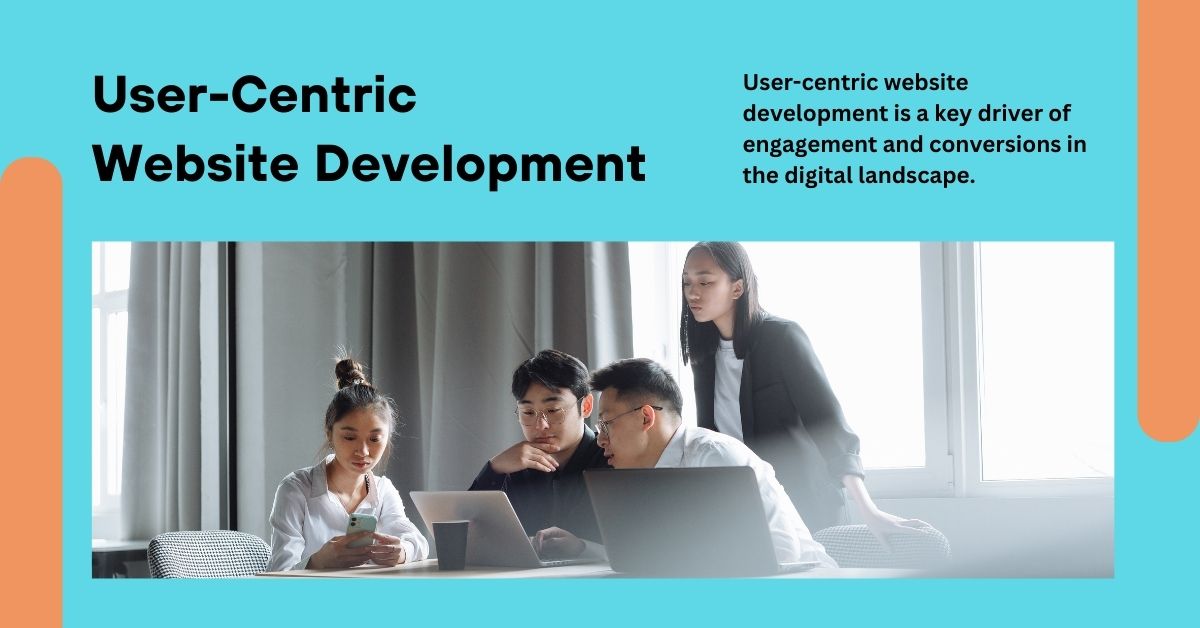In today’s digital landscape, creating a user-centric website has become crucial for businesses to succeed online. User-centric website development focuses on enhancing user engagement, satisfaction, and conversions by prioritizing the needs and preferences of the target audience.
This blog post explores the fundamental design principles and strategies that contribute to user-centric website development, helping businesses build websites that deliver exceptional experiences and drive meaningful results.
Understanding User-Centric Website Development
Understanding user-centric website development involves recognizing the importance of putting the user at the center of the design and development process. It involves gaining insights into user behaviors, needs, and preferences through research and analysis.
By understanding the target audience, businesses can create websites that are tailored to meet their specific requirements, resulting in enhanced engagement, satisfaction, and conversions. User-centric website development emphasizes usability, intuitive interfaces, personalized experiences, and optimization for different devices. It aims to create websites that prioritize user needs, leading to improved user experiences and ultimately driving business success.
Benefits of User-Centric Website Development
User-centric website development offers numerous benefits for businesses striving to create engaging and successful online experiences.
Firstly, it leads to enhanced user satisfaction and engagement. By prioritizing user needs and preferences, businesses can create websites that are intuitive, easy to navigate, and visually appealing. This results in a positive user experience, increasing the likelihood of users staying longer on the site, exploring more pages, and engaging with the content.
Secondly, user-centric website development can boost conversions and drive business growth. By understanding user behaviors and preferences, businesses can optimize their websites to align with user expectations, leading to higher conversion rates. Personalized experiences, persuasive content, and clear calls to action contribute to improved conversions and increased revenue.
Moreover, user-centric design helps build trust and credibility. When users feel that a website understands their needs and provides relevant solutions, they are more likely to trust the brand and its offerings. This can lead to increased customer loyalty and positive word-of-mouth referrals.
Additionally, user-centric websites often perform better in search engine rankings. Search engines prioritize websites that provide a positive user experience, considering factors such as mobile-friendliness, page load times, and user engagement. A well-designed user-centric website can improve its visibility in search results, driving more organic traffic and boosting online visibility.
Lastly, user-centric website development facilitates ongoing improvement and optimization. By collecting user feedback, analyzing website metrics, and staying updated with evolving user trends, businesses can continuously refine and enhance their websites. This iterative process ensures that the website remains relevant, engaging, and aligned with user expectations.
User Research and Persona Development
User research and persona development are essential components of user-centric website development, enabling businesses to better understand their target audience and tailor their websites to meet their specific needs.
User research involves gathering data and insights about the target users through various methods such as surveys, interviews, and analytics. This research helps uncover user behaviors, preferences, motivations, and pain points. By understanding their needs and expectations, businesses can design websites that address those needs effectively, resulting in a more engaging and satisfying user experience.
Persona development takes user research a step further by creating fictional representations of the target audience segments. Personas are detailed profiles that capture the characteristics, goals, behaviors, and preferences of typical users. These personas provide a deeper understanding of the user demographics, psychographics, and user journeys, allowing businesses to design their websites with specific user personas in mind.
By employing user research and persona development, businesses gain insights that inform various aspects of website design and development. This includes decisions on information architecture, content strategy, visual design elements, and functionality. By aligning the website’s structure and content with user needs, businesses can create intuitive navigation, relevant content, and personalized experiences that resonate with their target audience.
User research and persona development also contribute to improving usability, accessibility, and overall user satisfaction. By understanding user behaviors and preferences, businesses can identify pain points and areas for improvement, allowing them to optimize the website for a seamless and enjoyable user experience.
Intuitive Navigation and Seamless User Experience
Intuitive navigation and a seamless user experience are critical components of user-centric website development.
Intuitive navigation refers to the design and organization of a website’s menu structure, links, and navigation elements in a way that is easy for users to understand and navigate. It involves creating a clear and logical pathway for users to explore the website and find the information or functionalities they are seeking. Intuitive navigation ensures that users can quickly and effortlessly move between pages, sections, and categories, enhancing their overall browsing experience.
A seamless user experience refers to the smooth and uninterrupted flow of interactions between the user and the website. It involves eliminating friction points and creating a frictionless journey for users as they engage with the website. This includes optimizing page loading speed, reducing the number of steps required to complete tasks, and minimizing distractions or interruptions. A seamless user experience ensures that users can effortlessly access and interact with the website’s content or features, leading to increased engagement and satisfaction.
By implementing intuitive navigation and delivering a seamless user experience, businesses can enhance the usability and accessibility of their websites. Users can easily find what they are looking for, explore different sections of the website, and complete desired actions without frustration or confusion. Intuitive navigation and a seamless user experience contribute to higher user engagement, longer session durations, and increased conversions.
Furthermore, intuitive navigation and a seamless user experience contribute to building trust and credibility. When users can easily navigate and interact with a website without obstacles, they perceive the website as reliable and user-friendly. This positive experience fosters trust in the brand and encourages users to spend more time on the site, explore its offerings, and potentially convert into customers or subscribers.
Personalization and Customization
Personalization and customization are key elements of user-centric website development that aim to enhance user engagement and create tailored experiences.
Personalization involves delivering customized content, recommendations, and experiences to individual users based on their preferences, behaviors, and demographics. It utilizes data and insights gathered from user interactions, such as browsing history, purchase history, and demographic information, to provide relevant and targeted content. Personalization can be applied in various ways, such as displaying personalized product recommendations, showing location-specific information, or addressing users by their names. By personalizing the website experience, businesses can create a more personalized and engaging interaction, increasing user satisfaction and driving conversions.
Customization, on the other hand, allows users to personalize their own experience on the website. It provides users with the ability to adjust settings, choose preferences, and modify the layout or content based on their individual needs or preferences. Customization options can include selecting language preferences, adjusting font sizes, choosing color themes, or organizing content according to personal preferences. By empowering users to customize their experience, businesses can cater to their unique preferences, making the website more user-friendly and enhancing user satisfaction.
Personalization and customization contribute to a more user-centric approach by acknowledging and accommodating individual user differences and preferences. These strategies create a sense of personal connection, relevance, and ownership, which can lead to increased user engagement, loyalty, and repeat visits. By delivering personalized content and empowering users to customize their experience, businesses can create a more tailored and meaningful interaction, ultimately driving higher conversions and fostering long-term relationships with their audience.
Frequently Asked Questions
Q: What is user-centric website development?
A: User-centric website development is an approach that prioritizes the needs and preferences of users during the design and development process. It involves understanding user behaviors, conducting research, and creating websites that are tailored to provide an engaging and satisfying user experience.
Q: Why is user-centric website development important?
A: User-centric web development meets target audience needs, crafting intuitive, user-friendly websites with relevant content. This leads to higher user engagement, increased conversions, and improved customer satisfaction.
Q: How does user-centric website development enhance engagement?
A: User-centric website development enhances engagement by creating websites that are intuitive, easy to navigate, and visually appealing. By understanding user needs and preferences, businesses can design websites with personalized experiences, compelling content, and clear calls to action, resulting in increased user engagement and interaction with the website.
Q: What are some strategies for enhancing user engagement in website development?
A: Strategies for enhancing user engagement in website development include intuitive navigation, personalized content, interactive elements, clear and concise messaging, compelling visuals, and responsive design. These strategies aim to create a seamless and enjoyable user experience, encouraging users to stay longer on the website, explore more pages, and take desired actions.
Q: How does user-centric website development impact conversions?
A: User-centric website development impacts conversions by creating a user experience that is tailored to the target audience. By understanding user behaviors and preferences, businesses can optimize their websites with persuasive content, clear calls to action, and streamlined user flows, leading to higher conversion rates and increased customer acquisitions or sales.
Q: Can user-centric website development improve customer satisfaction?
A: Yes, user-centric website development can improve customer satisfaction. By focusing on user needs and preferences, businesses can create websites that are user-friendly, easy to navigate, and provide relevant and valuable content. This enhances the overall user experience, leading to higher levels of customer satisfaction and potentially fostering long-term relationships with customers.
Q: How can businesses measure the success of user-centric website development?
A: Businesses can measure the success of user-centric website development through various metrics, including user engagement metrics (such as time spent on the site, bounce rate, and page views), conversion rates, customer satisfaction surveys, and feedback from user testing. These metrics provide insights into the effectiveness of the website in meeting user needs and driving desired outcomes.
Q: Is user-centric website development a one-time process?
A: No, user-centric website development is an ongoing process. User behaviors and preferences evolve, and technology advancements continue to shape user expectations. To maintain a user-centric approach, businesses should regularly analyze user data, gather feedback, and make continuous improvements to the website to ensure it remains aligned with user needs and provides an optimal user experience.
Q: How can user-centric website development contribute to business growth?
A: User-centric website development can contribute to business growth by improving user engagement, increasing conversions, and fostering customer loyalty. By creating websites that are tailored to user needs, businesses can attract more visitors, drive conversions, and enhance customer satisfaction, ultimately leading to business growth and success.
Q: What role does user research play in user-centric website development?
A: User research plays a crucial role in user-centric website development. It involves gathering insights into user behaviors, preferences and needs through methods like surveys, interviews, and analytics. User research informs the design and development process, helping businesses understand their target audience better and create websites that effectively meet user expectations and enhance engagement and conversions.
Read More About Creating a Stunning Website: Essential Design Principles for Modern UI UX
Conclusion
User-centric website development is a key driver of engagement and conversions in the digital landscape. By prioritizing user needs and preferences, businesses can create websites that deliver exceptional experiences, foster trust, and drive meaningful results. Incorporating design principles such as intuitive interfaces, optimized performance, persuasive content, and personalization can transform websites into powerful tools for engaging users and achieving business objectives. By embracing user-centric principles, businesses can elevate their online presence and stand out in today’s competitive digital marketplace.



